When it comes to experiencing nature at its finest, Glacier National Park is a hiker’s dream. With its breathtaking landscapes, diverse hiking trails, and abundant wildlife, it offers a truly unforgettable adventure. Whether you’re a beginner looking for easy trails or an experienced hiker seeking a challenge, Glacier National Park has something for everyone.
In this guide, I will provide you with essential information and tips to make the most of your hiking experience in Glacier National Park. From the top trails to explore to the best seasons to visit, you’ll have all the knowledge you need to plan your hiking adventure.
Key Takeaways:
- Glacier National Park offers a variety of hiking trails suitable for all skill levels.
- Research the trail conditions and weather before embarking on a hiking trip.
- Summer is the most popular season for hiking, with easily accessible trails and pleasant weather.
- Winter hiking requires specialized equipment and careful consideration of weather conditions.
- Respect wildlife and follow park guidelines for a safe and enjoyable hiking experience.
Easy Hiking Trails in Glacier National Park
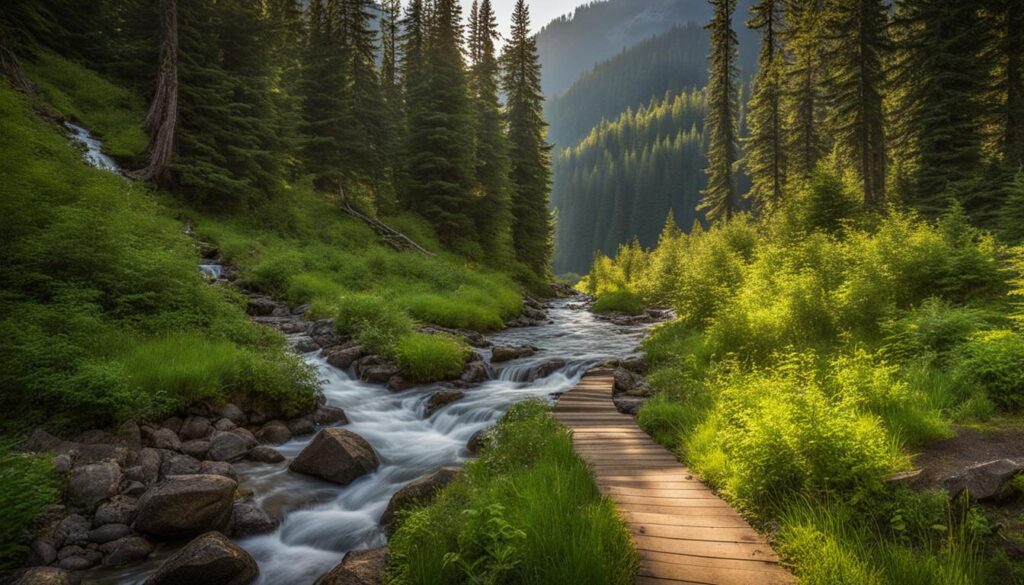
If you’re a beginner or simply looking for a leisurely hike in Glacier National Park, there are plenty of easy hiking trails to explore. These trails provide stunning views without requiring extensive hiking experience or high fitness levels. Here are a few popular options:
Trail of the Cedars
The Trail of the Cedars is a short and accessible loop trail located near Apgar Village. This scenic trail takes you through a lush forest of ancient cedar trees, providing a peaceful and serene hiking experience. The trail is wheelchair accessible and offers interpretive signs along the way, allowing you to learn about the park’s unique ecosystem.
Avalanche Lake Trail
The Avalanche Lake Trail is a moderately easy hike that leads to a stunning alpine lake nestled among towering peaks. The trail starts at the Trail of the Cedars and follows a gentle incline through a dense forest. Along the way, you’ll be treated to beautiful waterfalls and picturesque views. The destination, Avalanche Lake, offers a tranquil setting with crystal clear waters reflecting the surrounding mountains.
Hidden Lake Overlook Trail
The Hidden Lake Overlook Trail is located in the Logan Pass area and offers breathtaking views of Hidden Lake and the surrounding peaks. This relatively short hike takes you through alpine meadows filled with wildflowers, offering opportunities to spot wildlife such as mountain goats and bighorn sheep. The trail culminates in a stunning viewpoint overlooking the picturesque Hidden Lake.
These are just a few examples of easy hiking trails in Glacier National Park. Whether you’re a beginner or simply seeking a more relaxed hiking experience, these trails are perfect for enjoying the park’s natural beauty at a leisurely pace.
| Trail Name | Difficulty Level | Trail Length | Estimated Time |
|---|---|---|---|
| Trail of the Cedars | Easy | 0.7 miles (1.1 km) | 30 minutes |
| Avalanche Lake Trail | Moderate | 4.6 miles (7.4 km) | 2-3 hours |
| Hidden Lake Overlook Trail | Moderate | 2.8 miles (4.5 km) | 2-3 hours |
Hard Hiking Trails in Glacier National Park
Glacier National Park is known for its challenging and rewarding hiking trails that offer breathtaking views and opportunities to connect with nature. If you’re an experienced hiker seeking a thrilling adventure, these hard hiking trails in Glacier National Park are perfect for you.
Grinnell Glacier Trail
The Grinnell Glacier Trail is a strenuous yet awe-inspiring hike that leads to the stunning Grinnell Glacier. This 10.6-mile round trip trail takes you through alpine meadows, dense forests, and rugged terrain. Along the way, you’ll encounter jaw-dropping vistas of pristine lakes and towering mountains. The trail culminates at Grinnell Glacier, where you can witness the impressive ice formations and turquoise waters of the glacier-fed lake.
Highline Trail
The Highline Trail is a popular choice for experienced hikers looking for a challenging and exhilarating adventure. This 11.8-mile trail offers panoramic views of the park’s iconic alpine scenery, including the breathtaking Garden Wall. As you traverse the narrow trail, clinging to the mountainside, you’ll be rewarded with sweeping vistas of glacial valleys and snow-capped peaks. Keep an eye out for wildlife sightings, as the Highline Trail is known for its abundant wildlife.
Ptarmigan Tunnel Trail
The Ptarmigan Tunnel Trail is a unique and demanding hike that takes you through a historic tunnel carved into the mountainside. This 10.7-mile trail offers a combination of challenging terrain, stunning views, and a sense of adventure. As you make your way through the tunnel, you’ll emerge on the other side to be greeted by the breathtaking beauty of the Ptarmigan Wall and the alpine wonders it reveals. Be prepared for steep ascents and descents, as well as exposure to the elements.
To fully enjoy these hard hiking trails in Glacier National Park, it’s important to be well-prepared and equipped with proper gear. Make sure to check weather conditions, carry plenty of water, and pack essential items such as a map, compass, bear spray, and extra layers of clothing. It’s also recommended to hike with a partner and let someone know your hiking plans before venturing into the wilderness. With the right preparation and a sense of adventure, these hard hiking trails in Glacier National Park will provide unforgettable experiences and breathtaking memories.
Hiking in Glacier National Park: Summer vs Winter

When it comes to hiking in Glacier National Park, there are two distinct seasons that offer different experiences: summer and winter. Each season has its own unique charm and challenges, providing hikers with diverse opportunities to explore this breathtaking national park.
In summer, Glacier National Park is a hiker’s paradise. The trails are easily accessible, the weather is generally pleasant, and the stunning vistas are in full bloom. Hiking in Glacier National Park in summer allows you to witness the park’s vibrant colors, lush greenery, and wildflowers in full bloom. The clear blue skies and mild temperatures create an inviting atmosphere for outdoor adventures.
On the other hand, winter hiking in Glacier National Park unveils a whole new world of beauty and serenity. While the trails may be covered in snow, the landscape becomes a wonderland of icy splendor. Hiking in Glacier National Park in winter offers a chance to experience the peaceful stillness of nature and witness the awe-inspiring scenery blanketed in snow. However, it’s important to note that winter hiking requires specialized equipment, such as snowshoes or cross-country skis, to navigate the snowy terrain safely.
Whether you choose to hike in summer or winter, seasonal hiking in Glacier National Park offers its own set of rewards and challenges. It’s important to plan accordingly, considering factors like trail conditions, weather forecasts, and your own hiking abilities. With proper preparation and a spirit of adventure, you can embark on a memorable hiking journey in Glacier National Park, immersing yourself in the stunning beauty of nature.
Hiking in Glacier National Park: Key Differences between Summer and Winter
| Season | Key Highlights |
|---|---|
| Summer |
|
| Winter |
|
“Hiking in Glacier National Park in summer allows you to witness the park’s vibrant colors, lush greenery, and wildflowers in full bloom.”
“Winter hiking in Glacier National Park offers a chance to experience the peaceful stillness of nature and witness the awe-inspiring scenery blanketed in snow.”
Historical Significance of Glacier National Park
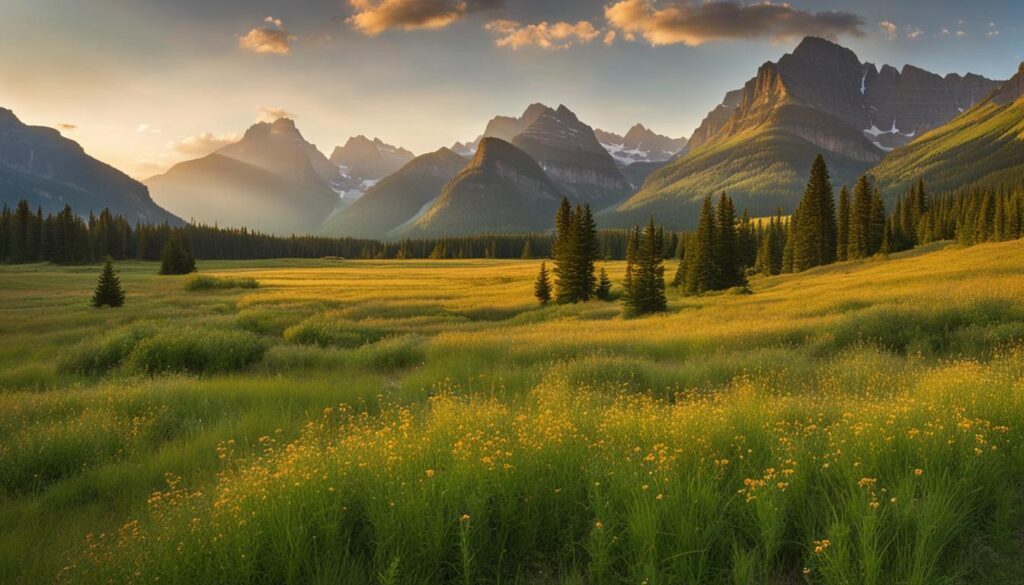
Glacier National Park holds a rich historical significance, offering visitors a glimpse into the past. From its ties to Native American tribes to its role in the development of the National Park System, the park is steeped in history. Exploring the historical sites within Glacier National Park allows visitors to connect with the land and understand its cultural and historical value.
Native American Influence
The history of Glacier National Park dates back thousands of years when it was inhabited by Native American tribes, including the Blackfeet, Salish, and Kootenai. These tribes considered the land sacred and relied on its resources for sustenance and spiritual practices. Today, visitors can learn about the traditions and culture of these tribes through interpretive programs and exhibits.
“Glacier National Park holds significant historical value, as it was once home to Native American tribes and later became a part of the westward expansion.”
Westward Expansion and the National Park System
In the late 19th century, the arrival of European settlers brought significant changes to the area surrounding Glacier National Park. The completion of the Great Northern Railway in 1891 played a crucial role in opening up the region for tourism and exploration. As more people discovered the beauty of the area, efforts began to preserve and protect the land.
In 1910, Glacier National Park was established as the country’s 10th national park, thanks to the advocacy of individuals like George Bird Grinnell and the support of President William Howard Taft. This marked an important milestone in the development of the National Park System, creating a legacy of conservation and preservation that continues to this day.
Exploring Historical Sites
Visitors to Glacier National Park can explore a range of historical sites that showcase its past. The iconic Going-to-the-Sun Road, constructed in the 1930s, offers breathtaking views and is a testament to human ingenuity. The Many Glacier Hotel, built in 1915, is a grand Swiss-style lodge that has welcomed guests for over a century. For those seeking a rustic experience, the Granite Park Chalet provides a glimpse into early park development and offers stunning views of the surrounding mountains.
| Historical Site | Description |
|---|---|
| Going-to-the-Sun Road | A scenic road that spans the park and showcases stunning mountain vistas. |
| Many Glacier Hotel | A historic Swiss-style lodge offering stunning views of the surrounding landscape. |
| Granite Park Chalet | A rustic backcountry chalet offering a unique lodging experience. |
Exploring these historical sites allows visitors to appreciate the stories and significance that live within Glacier National Park, connecting them to the past and deepening their understanding of the park’s cultural and historical importance.
Geological Wonders in Glacier National Park

Glacier National Park is a treasure trove of mesmerizing geological formations that showcase the beauty and power of nature. From towering mountain peaks to deep glacial valleys, the park’s unique geology leaves visitors in awe. One of the most remarkable features is the Logan Pass, situated at an elevation of 6,646 feet. This scenic viewpoint offers panoramic vistas of the surrounding mountains and valleys, allowing you to witness the dramatic effects of glaciation.
Another geological wonder in Glacier National Park is the renowned Grinnell Glacier. This ancient ice mass is a remnant of the park’s glacial past and serves as a reminder of the dynamic forces that shaped the landscape. As you hike along the Grinnell Glacier Trail, you’ll be treated to breathtaking views of the glacier, which has gradually receded over the years.
One of the park’s hidden gems is the picturesque Lake McDonald. Nestled amidst the mountains, this serene lake boasts crystal-clear waters and is surrounded by towering cliffs. The vibrant colors of the lake reflect the unique rock formations that lie beneath its surface, creating a visual spectacle that is a feast for the eyes.
Glacier National Park Geological Formations:
| Formation | Description |
|---|---|
| Going-to-the-Sun Road | This iconic road winds through the park, offering breathtaking views of glacially-carved valleys and rugged mountains. |
| Granite Park Chalet | Perched high in the mountains, this historic chalet offers stunning views of the surrounding granite peaks and valleys. |
| Grinnell Glacier | One of the park’s most famous glaciers, Grinnell Glacier showcases the power of ice in shaping the landscape over thousands of years. |
| Hidden Lake | Nestled at the foot of towering mountains, Hidden Lake offers a glimpse into the park’s glacial history and provides a serene backdrop for hikers. |
Exploring the geological wonders of Glacier National Park is a truly awe-inspiring experience. From the majestic peaks to the ancient glaciers, every corner of the park unveils a story of Earth’s natural forces at work. Whether you’re a geology enthusiast or simply appreciate the beauty of nature, Glacier National Park is sure to leave an indelible mark on your heart.
Wildlife in Glacier National Park
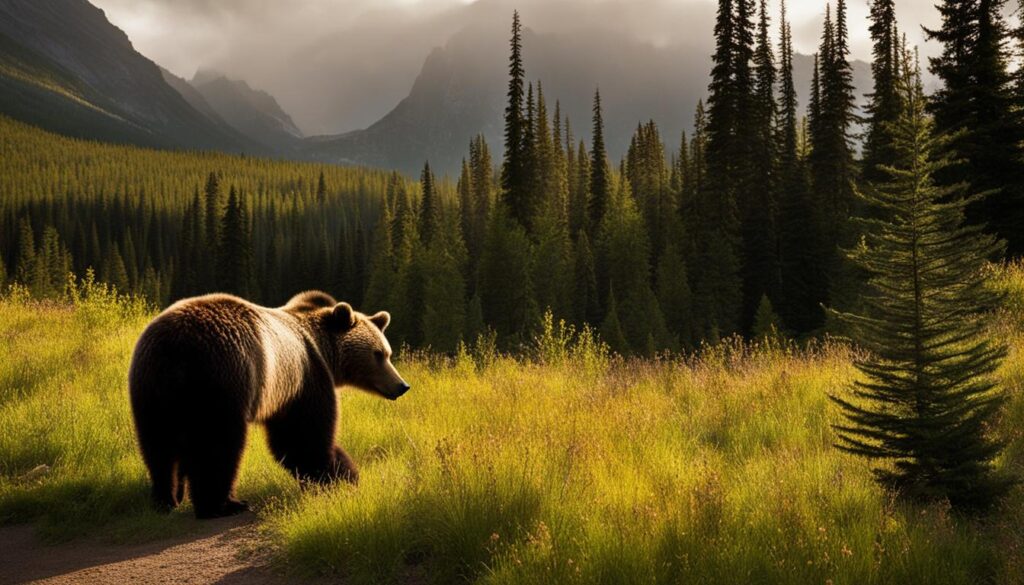
Glacier National Park is teeming with diverse wildlife, providing visitors with the opportunity to observe and appreciate the natural wonders of this pristine ecosystem. With over 70 species of mammals and more than 270 species of birds, the park offers a remarkable wildlife experience. From iconic animals like grizzly bears and mountain goats to smaller creatures such as pikas and marmots, there is always a chance to encounter fascinating wildlife in Glacier National Park.
The park’s rich biodiversity is a result of its varied habitats, including alpine meadows, dense forests, and shimmering lakes. As you explore the park’s hiking trails and scenic viewpoints, keep a keen eye out for wildlife sightings. Remember to maintain a respectful distance and avoid disturbing or feeding the animals. It is important to observe wildlife from a safe distance to ensure their well-being and your own safety.
Glacier National Park not only offers the opportunity to observe animals in their natural habitat but also provides a chance to learn about their role in the park’s ecosystem. As you hike through the park, take note of the delicate balance between predators and prey, the adaptations that allow animals to thrive in harsh mountain environments, and the interconnectedness of all living creatures in this remarkable ecosystem.
Notable Wildlife in Glacier National Park
- Grizzly bears
- Black bears
- Bighorn sheep
- Mountain goats
- Elk
- Wolves
- Coyotes
- Moose
- Wolverines
- Bobcats
These are just a few examples of the incredible wildlife that call Glacier National Park home. Each animal plays a vital role in the park’s delicate ecosystem, and observing them in their natural habitat is a truly memorable experience.
Scenic Viewpoints in Glacier National Park
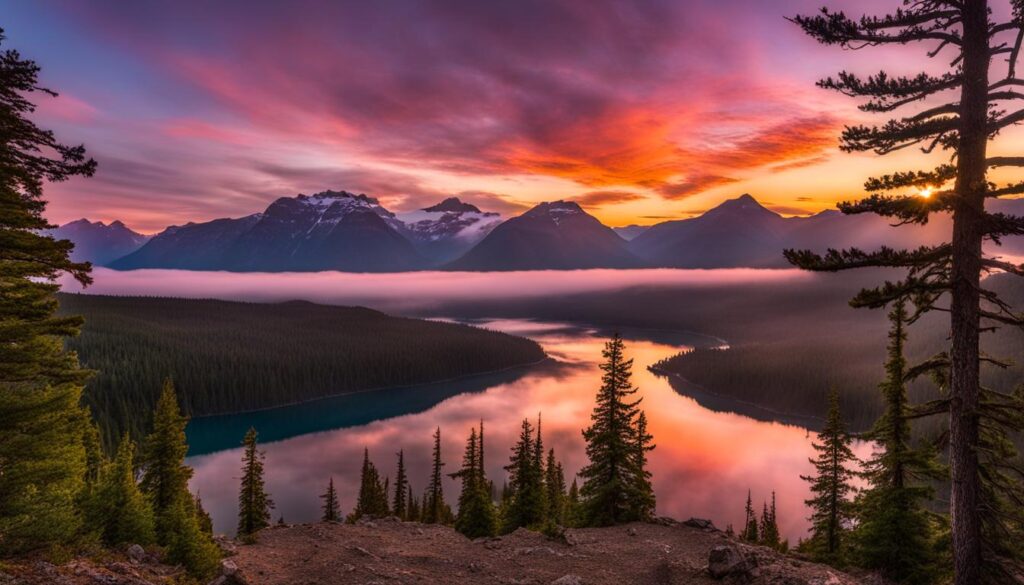
Glacier National Park is a treasure trove of picturesque landscapes, offering several breathtaking scenic viewpoints that provide awe-inspiring panoramic views of the surrounding natural beauty. These viewpoints allow visitors to immerse themselves in the majesty of the park and capture memorable photographs that showcase the grandeur of Glacier National Park.
Spectacular Views Await
One of the most renowned viewpoints in Glacier National Park is Logan Pass. Situated along the famous Going-to-the-Sun Road, Logan Pass offers sweeping vistas of the rugged mountains and verdant valleys that make the park so captivating. At an elevation of 6,646 feet, this vantage point provides a stunning perspective of the park’s diverse terrain, including glacial valleys and pristine alpine meadows.
Another incredible viewpoint is Swiftcurrent Lookout. Located near the iconic Many Glacier Hotel, this lofty perch offers mesmerizing views of the surrounding mountains and the tranquil Swiftcurrent Lake. Visitors can savor the breathtaking beauty of the park from this elevated spot while being serenaded by the sounds of nature.
Awe-Inspiring Nature at Every Turn
For a truly unforgettable experience, head to the Many Glacier Valley. This scenic area boasts stunning views of towering peaks, sparkling lakes, and cascading waterfalls. Whether you’re gazing at the majestic Grinnell Glacier or marveling at the tranquility of Lake Josephine, the Many Glacier Valley is an idyllic destination for any nature enthusiast.
| Scenic Viewpoint | Location | Description |
|---|---|---|
| Logan Pass | Going-to-the-Sun Road | Offers panoramic views of mountains and valleys. |
| Swiftcurrent Lookout | Near Many Glacier Hotel | Provides mesmerizing views of mountains and Swiftcurrent Lake. |
| Many Glacier Valley | Many Glacier Area | Encompasses stunning views of peaks, lakes, and waterfalls. |
These are just a few examples of the scenic viewpoints that await you in Glacier National Park. Each vista offers its own unique perspective and showcases the extraordinary beauty of the park. Make sure to bring your camera and capture the moments that will forever remind you of the splendor and magnificence found in Glacier National Park.
Trip Planning for Hiking in Glacier National Park
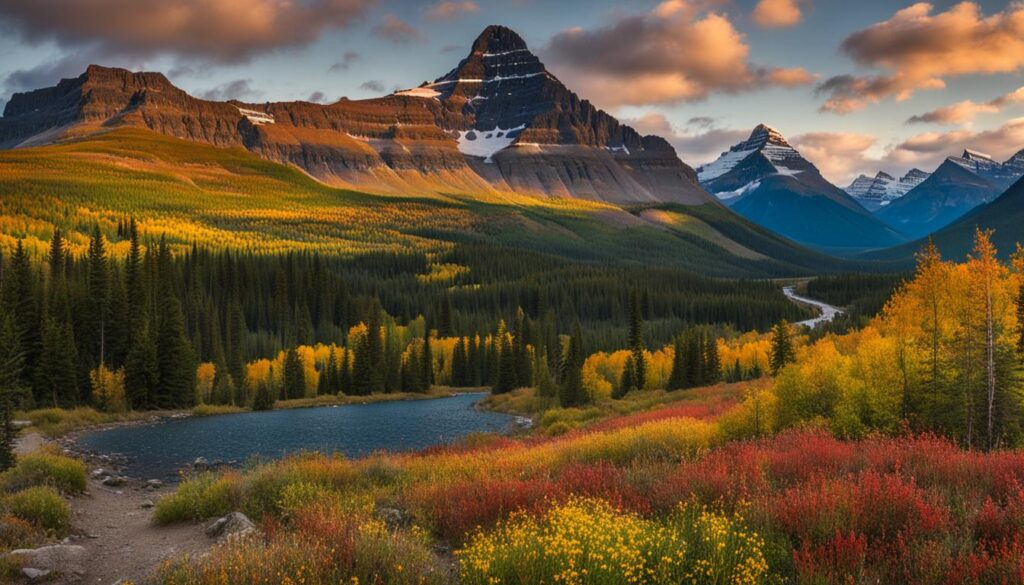
When embarking on a hiking adventure in Glacier National Park, thorough trip planning is essential to ensure a safe and enjoyable experience. Here are some key considerations to keep in mind when planning your hiking trip:
Glacier National Park Visitor Information
Before setting off on your hike, it’s crucial to gather relevant visitor information about Glacier National Park. The park’s official website is an excellent resource, providing details on trail conditions, closures, and any specific regulations or guidelines that hikers need to be aware of. Additionally, be sure to check the park’s operating hours and entrance fees, as well as any updated visitor center information for maps and expert advice.
Permits for Hiking in Glacier National Park
Depending on the specific trail you plan to hike, you may need to obtain a permit. Some popular trails, such as the Grinnell Glacier Trail, require a permit due to limited trail access to preserve the natural environment. It’s important to check the park’s website or contact the relevant authorities to understand if your chosen trail requires a permit and to secure one in advance. This will help ensure that you have the necessary authorization and can enjoy your hike without any issues.
| Hiking Permit Types | Duration | Cost |
|---|---|---|
| Day Hike Permit | 1 day | $10 |
| Backcountry Camping Permit | Multiple days | $7 per person per night |
Transportation and Accommodations
When planning your trip, consider your transportation options to Glacier National Park. The park is well-connected by road, and driving is a popular choice for many visitors. However, it’s essential to take into account parking availability, as some popular trailheads can fill up quickly during peak season. Additionally, if you prefer not to drive, you can explore alternative transportation options such as shuttle services or guided tours.
For overnight trips, make sure to book accommodations well in advance, especially during peak months. Glacier National Park offers a range of accommodation options, including lodges, campsites, and backcountry camping. Whichever option you choose, be sure to follow the park’s guidelines and regulations regarding camping and overnight stays.
By thoroughly planning your hiking trip to Glacier National Park, you can ensure a safe and memorable experience surrounded by the park’s breathtaking natural beauty.
Safety Tips for Hiking in Glacier National Park
When embarking on a hiking adventure in Glacier National Park, it’s essential to prioritize safety to ensure a enjoyable and incident-free experience. Here are some important safety tips to keep in mind:
1. Be Prepared for Changing Weather Conditions
Glacier National Park is known for its unpredictable weather patterns, so it’s crucial to be prepared for sudden changes. Dress in layers and carry extra clothing to protect yourself from cold, wind, and rain. Additionally, pack sunscreen, sunglasses, and a hat to shield yourself from the sun’s rays.
2. Carry Essential Safety Gear
When hiking in Glacier National Park, it’s important to carry essential safety gear. One of the most vital pieces of equipment is bear spray, which can deter aggressive wildlife encounters. It’s also advisable to carry a well-stocked first aid kit to handle any injuries or emergencies that may arise on the trail.
3. Follow Park Guidelines for Wildlife Encounters
Glacier National Park is home to a wide variety of wildlife species, including bears, mountain goats, and elk. It’s crucial to respect these animals’ space and observe them from a safe distance. Always follow park guidelines for wildlife encounters, such as maintaining a minimum distance of 100 yards from bears and staying on designated trails.
By adhering to these safety tips, you can enjoy your hiking adventure in Glacier National Park while minimizing potential risks and ensuring a safe and unforgettable experience.
| Hiking Safety Tips |
|---|
| Be Prepared for Changing Weather Conditions |
| Carry Essential Safety Gear |
| Follow Park Guidelines for Wildlife Encounters |
Conclusion
As I wrap up this comprehensive hiking guide to Glacier National Park, I hope you’re feeling excited and well-prepared for your adventure. With its stunning landscapes, diverse trails, and abundant wildlife, Glacier National Park offers an unforgettable hiking experience.
Remember, when exploring this natural wonder, it’s essential to prioritize safety. Make sure you have the necessary hiking essentials for Glacier National Park, including proper footwear, layered clothing, a map and compass, plenty of water, and snacks to keep you energized.
Additionally, follow the tips and information provided throughout this guide to enhance your hiking experience. From easy trails suitable for beginners to challenging hikes for seasoned adventurers, Glacier National Park has something for everyone. Take the time to plan your trip, familiarize yourself with the park regulations, and be prepared to respect and appreciate the natural environment.
So, lace up your hiking boots, pack your backpack, and get ready to embark on an incredible journey through Glacier National Park. Happy hiking!
FAQ
When is the best time to hike in Glacier National Park?
The best time to hike in Glacier National Park is during the summer months, from June to September. The trails are easily accessible, and the weather is usually pleasant.
What are some easy hiking trails in Glacier National Park?
Some easy hiking trails in Glacier National Park include the Trail of the Cedars, Avalanche Lake Trail, and Hidden Lake Overlook Trail.
Are there challenging hiking trails in Glacier National Park?
Yes, Glacier National Park offers challenging hiking trails for experienced hikers. Some of these include the Grinnell Glacier Trail, Highline Trail, and Ptarmigan Tunnel Trail.
Can I hike in Glacier National Park during winter?
Yes, winter hiking is possible in Glacier National Park. However, it requires specialized equipment, such as snowshoes or cross-country skis, and careful consideration of weather conditions and snowpack stability.
What historical sites can I visit in Glacier National Park?
Some historical sites in Glacier National Park include the Going-to-the-Sun Road, Many Glacier Hotel, and the Granite Park Chalet.
What geological formations can I see in Glacier National Park?
Glacier National Park is known for its towering mountains, glacial valleys, and pristine lakes. Highlights include the Logan Pass, Grinnell Glacier, and Lake McDonald.
What kind of wildlife can I encounter in Glacier National Park?
Glacier National Park is home to over 70 species of mammals and more than 270 species of birds. Visitors may encounter grizzly bears, mountain goats, bighorn sheep, and elk, among others.
Where can I find the best scenic viewpoints in Glacier National Park?
Some popular scenic viewpoints in Glacier National Park are Logan Pass, Swiftcurrent Lookout, and Many Glacier Valley. These locations offer stunning panoramic views of the park’s landscapes.
What should I consider when planning a hiking trip to Glacier National Park?
When planning a hiking trip to Glacier National Park, it is important to research trail conditions, obtain necessary permits, and familiarize yourself with park regulations and safety protocols. Additionally, consider factors such as transportation, accommodations, and weather conditions.
How can I ensure a safe hiking experience in Glacier National Park?
To ensure a safe hiking experience in Glacier National Park, be prepared for changing weather conditions, carry essential safety gear such as bear spray and a first aid kit, and follow park guidelines for wildlife encounters. It is also crucial to inform someone of your hiking plans and stick to designated trails.
How can I make the most of my hiking adventure in Glacier National Park?
By following the tips and information provided in this guide, you can make the most of your hiking adventure in Glacier National Park. Remember to prioritize safety, respect the natural environment, and enjoy the beauty of this remarkable national park.

